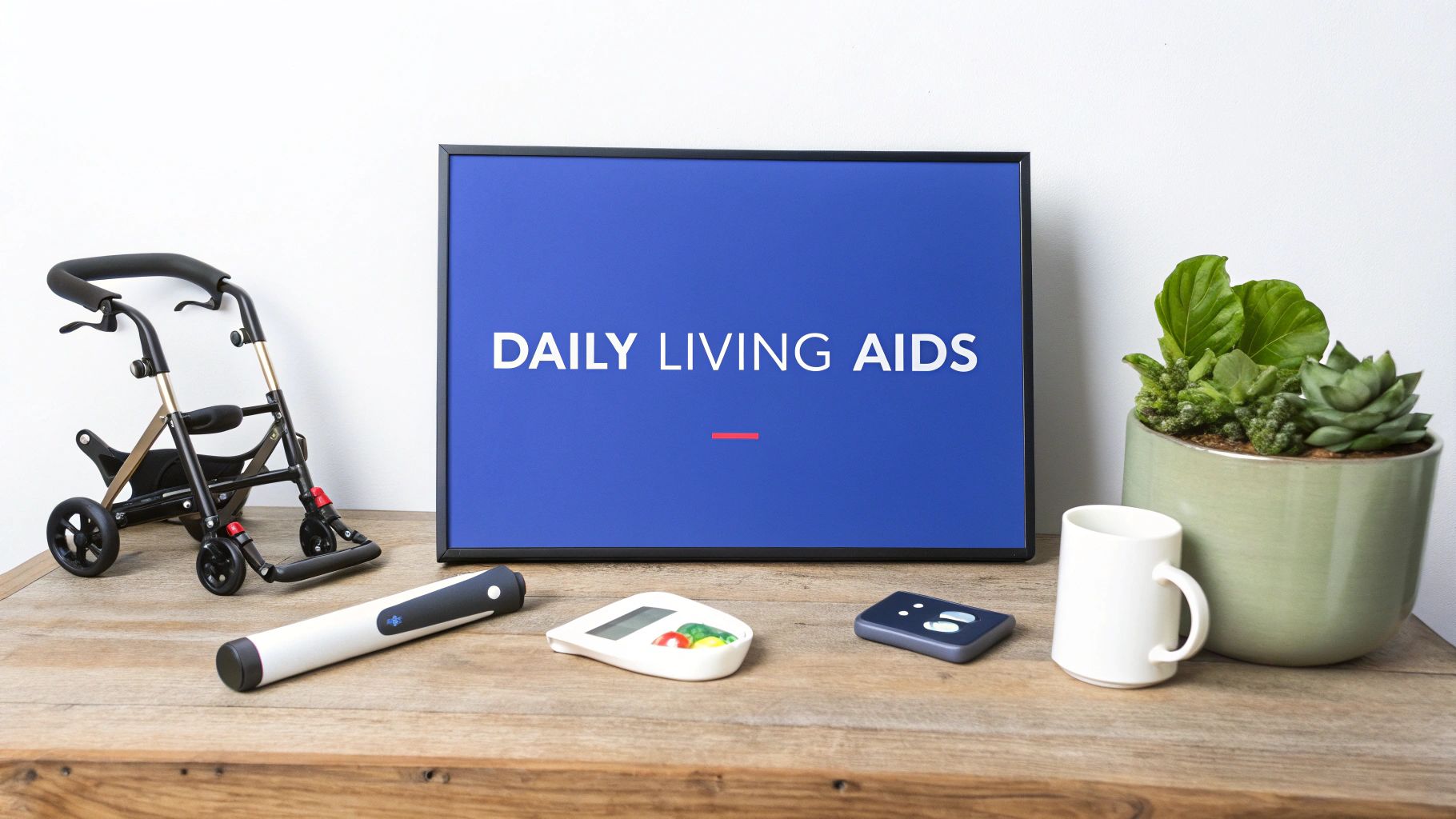Empowering Independence: Aids for Daily Living
Maintaining independence is crucial for seniors and individuals with disabilities. This listicle highlights eight aids for daily living (ADLs) to simplify everyday tasks and enhance safety. Discover how these tools, from smart home devices to adaptive equipment, can empower individuals and improve their quality of life. These aids for daily living address common challenges with mobility, medication management, and personal care. Let's explore these solutions.
1. Amazon Echo Show 8 (3rd Gen)
The Amazon Echo Show 8 (3rd Gen) stands out as a versatile and practical aid for daily living, seamlessly blending technology with everyday needs. It transforms how individuals, particularly seniors and those with mobility limitations, manage their daily routines, stay connected, and maintain independence within their homes. This smart display goes beyond simple voice commands, offering a visual and interactive experience that simplifies complex tasks and enhances communication. This device is particularly beneficial for seniors aging in place, individuals with chronic illnesses requiring specialized care, and family caregivers seeking reliable support.

The Echo Show 8’s 8-inch HD touchscreen with adaptive color technology presents information clearly and vividly, making it easy to read even from a distance. This is a significant advantage for seniors experiencing age-related vision changes. The built-in Alexa voice assistant empowers hands-free control, allowing users to operate the device without needing to physically interact with buttons or menus. This feature is invaluable for individuals with limited dexterity or mobility.
For family caregivers, the Echo Show 8 offers peace of mind by facilitating regular communication and remote monitoring. The 13MP camera with auto-framing allows for high-quality video calls, enabling families to stay connected and visually check in on loved ones. The medication and appointment reminder capabilities further assist seniors in managing their health, ensuring they take medications on time and attend scheduled appointments. These features reduce the burden on caregivers and provide a safety net for seniors living independently.
Beyond personal use, the Echo Show 8 integrates seamlessly into a smart home ecosystem. Acting as a central hub, it can control compatible devices such as lights, thermostats, and security systems. Voice commands can adjust room temperature, turn off lights, or lock doors, promoting independence and safety, especially for those with mobility challenges. Imagine a scenario where a senior, after getting into bed, can simply say, "Alexa, turn off the living room lights," eliminating the need to get up and walk across the room.
Pricing and Technical Requirements: The Amazon Echo Show 8 is generally available at a competitive price point (check the Amazon website for current pricing: https://www.amazon.com/echo). It requires a stable internet connection for full functionality and a standard power outlet.
Comparison with Similar Tools: While other smart displays exist, the Echo Show 8 distinguishes itself with its robust integration with Amazon's ecosystem of services and devices. Its large screen, adaptive color technology, and powerful camera also contribute to a superior user experience, particularly for seniors.
Implementation and Setup Tips: Setting up the Echo Show 8 is straightforward. Simply plug it into a power outlet, connect it to your Wi-Fi network, and log in to your Amazon account. Personalized settings, such as medication reminders and contact information for video calls, can be easily configured through the intuitive touchscreen interface. It’s advisable to place the device in a central location within the home for optimal voice control and visibility.
Pros and Cons:
Pros:
- Hands-free operation ideal for mobility limitations
- Large, clear display easy to read
- Extensive smart home integration
- Regular software updates and new features
- Enhanced communication through video calling and messaging
Cons:
- Requires stable internet connection
- Privacy concerns with always-listening device (mitigated by a physical mute button)
- Monthly subscription needed for some premium features (though core functionality remains free)
- Limited battery life when unplugged (designed primarily for stationary use)
The Amazon Echo Show 8 earns its place on this list of aids for daily living because it offers a practical, user-friendly solution for enhancing independence, safety, and connection for seniors, individuals with disabilities, and their caregivers. Its versatility, combined with regular software updates and expanding features, makes it a valuable investment in improving quality of life and facilitating aging in place. It addresses the specific needs of our target audience, providing practical support for seniors, respite for caregivers, and a valuable resource for healthcare professionals.
2. Philips Lifeline Medical Alert System
Maintaining independence and safety at home is a priority for many, particularly seniors and individuals with certain medical conditions. Aids for daily living, such as medical alert systems, can significantly contribute to this goal. The Philips Lifeline Medical Alert System stands out as a comprehensive and reliable solution, offering 24/7 emergency response services designed to provide peace of mind for users and their families. This system deserves its place on this list because of its long-standing reputation, robust features, and focus on rapid response in emergencies.
At its core, the Philips Lifeline system connects users to trained care specialists through a wearable help button. When activated, the button triggers a two-way communication link through a base station connected to your landline or cellular network. The care specialist can then assess the situation, speak directly with the user, and dispatch the appropriate help – whether it's emergency medical services, family members, or neighbors. This professional monitoring element is a key differentiator, ensuring that help is always available, even if family members are unavailable or live far away. This is particularly beneficial for seniors living alone or those managing chronic conditions that could require immediate medical attention.
The Philips Lifeline system boasts a range of features designed for ease of use and effectiveness: a waterproof help button allows users to wear the device even in the shower, a common location for falls; two-way communication through the base station ensures clear and direct contact with the monitoring center; and GPS-enabled mobile options extend the system's reach beyond the home, providing a safety net for users while on the go. Select models also offer fall detection technology, automatically triggering an alert if a fall is detected, even if the user is unable to press the help button themselves. This is particularly useful for individuals at high risk of falls.
While the core functionality remains consistent, Philips Lifeline offers different plans and packages to cater to individual needs. This allows users to select the best option based on their specific requirements and budget. For instance, you can choose between a landline-based system or a cellular-based system, depending on your home communication setup. GPS-enabled mobile pendants are available for those seeking protection outside the home. Learn more about Philips Lifeline Medical Alert System and the various in-home senior care solutions available.
Like any aid for daily living, the Philips Lifeline system has its pros and cons. On the positive side, it boasts a proven track record with over 45 years of service, providing assurance of reliability and experience. The waterproof devices enhance safety during showering, and the professional monitoring service ensures a swift and appropriate response, often within a minute. Compared to systems that simply notify family members, Philips Lifeline provides a direct link to trained professionals who can assess the situation and coordinate the most appropriate response.
However, the service does come with monthly subscription fees, typically ranging from $50 to $70 depending on the chosen plan and features. This is an important factor to consider when budgeting for aids for daily living. The system also requires a functioning landline or cellular connection, and while the basic models provide a reliable connection within a certain range of the base station, the range can be limited. Furthermore, fall detection technology, while beneficial, can sometimes result in false alarms, which can be disruptive.
Implementing the Philips Lifeline system is relatively straightforward. The base station needs to be plugged into a power outlet and connected to your phone line or cellular network. The user then wears the help button as a pendant or on their wrist. Testing the system regularly is crucial to ensure proper functioning and familiarize the user with its operation.
If you or a loved one are considering aids for daily living to enhance safety and independence, the Philips Lifeline Medical Alert System is a worthwhile option. It offers a comprehensive suite of features, 24/7 professional monitoring, and a long-standing reputation for reliability. While the monthly subscription fees and technical requirements should be considered, the peace of mind and rapid response capabilities make it a valuable investment in personal safety and well-being. You can explore more about the system and its various options on their website: https://www.philips.com/lifeline.
3. GripWare Non-Slip Tableware Set
Maintaining independence during mealtimes is a crucial aspect of dignified aging and overall well-being. For individuals experiencing diminished hand strength, arthritis, tremors, or other coordination challenges, using standard tableware can become frustrating and even dangerous. The GripWare Non-Slip Tableware Set offers a practical and affordable solution to these difficulties, promoting safer and more enjoyable dining experiences. This set is a valuable aid for daily living, allowing individuals to regain control and dignity during mealtimes. It addresses the common struggles faced by seniors and those with limited dexterity, making it a worthwhile investment for improved quality of life.
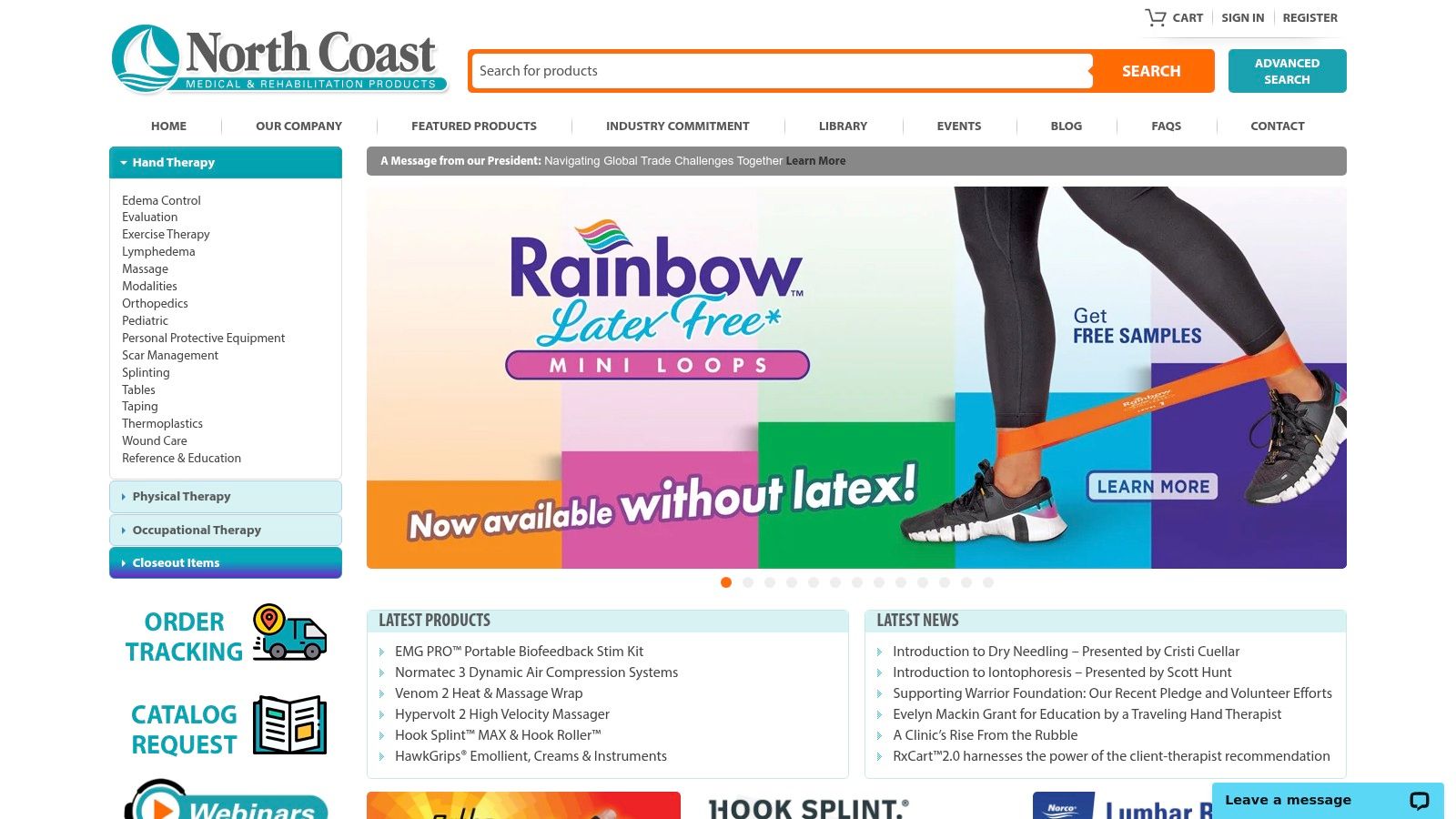
The GripWare set stands out due to several key features designed for ease of use and increased independence. The non-slip rubber base on each piece prevents sliding and spills, offering stability and reducing the risk of accidents. This is particularly beneficial for individuals with tremors or weakened grip. Furthermore, the high-contrast colors of the tableware provide enhanced visual clarity, making it easier for those with low vision to distinguish food and utensils. The built-up handles on the cups, mugs, and utensils provide a larger, more comfortable gripping surface, requiring less hand strength and reducing strain. This design is particularly helpful for individuals with arthritis or limited hand mobility. The set includes plates, bowls, cups, and adaptive utensils, providing a comprehensive solution for various dining needs. The materials are dishwasher and microwave safe, simplifying cleanup and everyday use.
For family caregivers, the GripWare set offers peace of mind knowing their loved ones can eat more safely and independently. It reduces the need for constant assistance during mealtimes, allowing caregivers to focus on other aspects of care. For healthcare professionals, including hospital discharge planners, the GripWare set represents a practical and cost-effective recommendation for patients transitioning back home after illness or injury. It facilitates a smoother transition to independent living and aids in recovery.
While the GripWare Non-Slip Tableware Set offers numerous benefits as an aid for daily living, it's important to consider some potential drawbacks. Some users find the design to be more functional than aesthetically pleasing, perceiving it as somewhat institutional. The tableware is also heavier than standard tableware, which may be a concern for individuals with very limited strength. Currently, the GripWare set has limited size options, which may not suit all individual preferences or needs. Finally, the rubber non-slip base can wear out over time with extended use, requiring eventual replacement.
Compared to other adaptive dining equipment, such as weighted utensils or specialized plate guards, the GripWare set offers a more affordable and versatile solution. It addresses multiple challenges related to hand strength, coordination, and vision, making it a valuable all-in-one aid. While specialized equipment may be necessary for specific conditions, the GripWare set serves as an excellent starting point for many individuals seeking greater independence during mealtimes.
While pricing can vary depending on the retailer and specific set components, the GripWare Non-Slip Tableware Set generally falls within a reasonable price range, making it accessible to a wider audience. You can find the GripWare set and other aids for daily living on the North Coast Medical website (https://www.northcoastmedical.com). When implementing the GripWare set, consider individual needs and preferences. Start by introducing a few pieces at a time, allowing the user to adjust to the new tableware. Encourage feedback and make adjustments as needed. Ensure proper cleaning and maintenance to prolong the lifespan of the rubber base. For individuals with specific dietary restrictions or preferences, consider supplementing the set with other adaptive equipment if necessary.
By providing a stable, easy-to-grip, and visually clear dining experience, the GripWare Non-Slip Tableware Set empowers individuals to reclaim their mealtime independence and improve their overall quality of life. It’s a valuable tool for seniors, those with disabilities, and their caregivers, making everyday dining a more comfortable, safe, and enjoyable experience. This aid for daily living truly addresses a significant need and deserves its place on this list of helpful tools.
4. Reacher Grabber Tool (32-inch)
Maintaining independence is a cornerstone of well-being, especially for seniors and individuals with mobility challenges. Aids for daily living, such as the reacher grabber tool, can significantly contribute to this independence by simplifying everyday tasks and reducing the risk of falls. The 32-inch reacher grabber is a simple yet effective tool that empowers individuals to retrieve items without straining or overreaching. This makes it an invaluable aid for daily living for a wide range of users, from seniors aging in place to individuals recovering from surgery. By extending reach, it helps maintain a sense of self-sufficiency and reduces reliance on others for simple tasks.
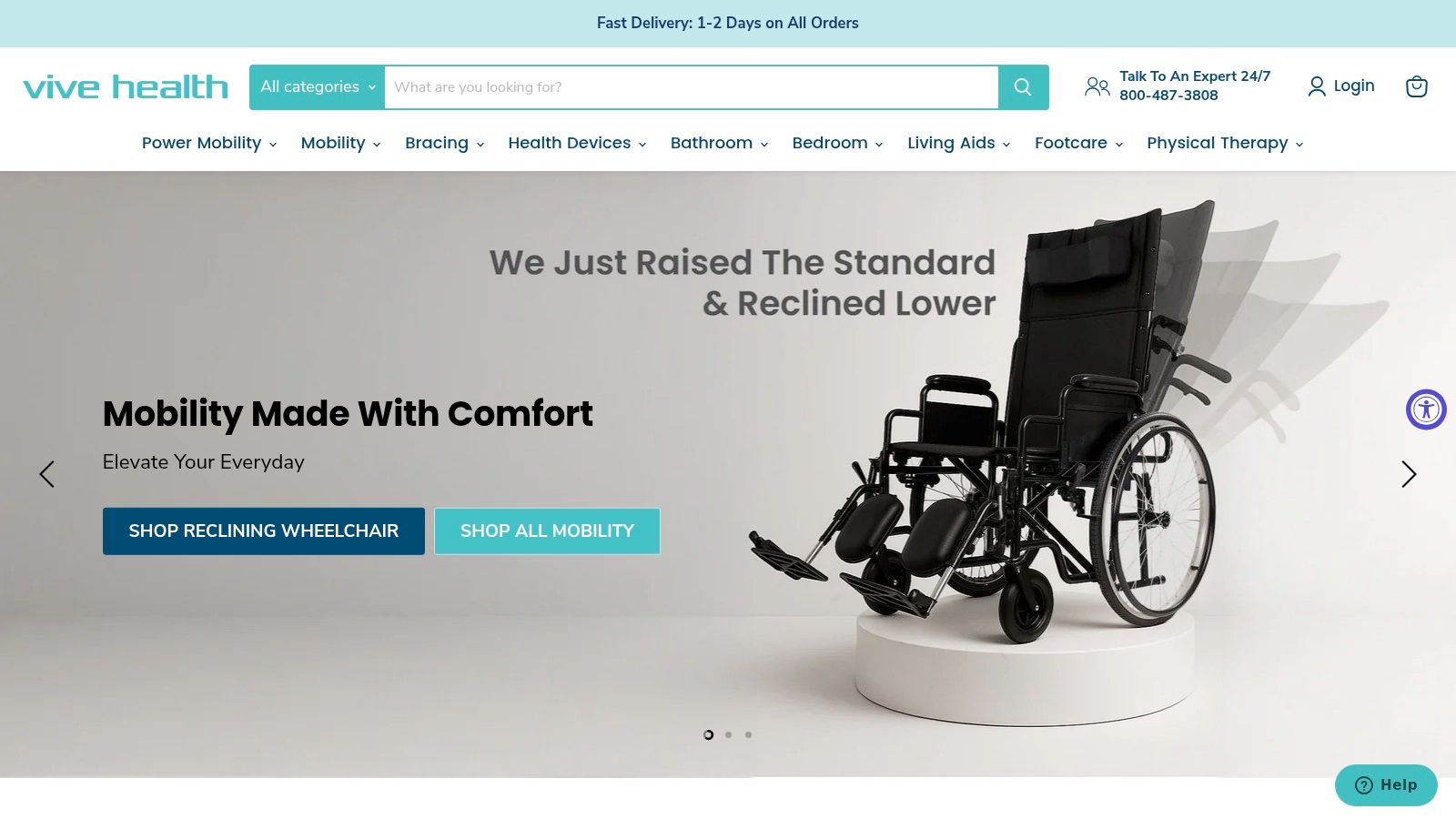
The 32-inch reacher grabber proves invaluable in numerous daily situations. Imagine retrieving a can of soup from a high pantry shelf without precariously balancing on a step stool. Or picking up a dropped piece of clothing from the floor without painful bending. These seemingly small tasks can become significant hurdles for individuals with limited mobility. This tool transforms these challenges into effortless actions, promoting safety and preserving dignity. The reacher's ergonomic handle, designed for comfortable gripping, minimizes strain on the hand and wrist, even during extended use. This is particularly beneficial for individuals with arthritis or other conditions affecting hand dexterity.
This particular model boasts several features that enhance its usability. The lightweight aluminum construction, typically under one pound, makes it easy to maneuver, even for those with limited upper body strength. The rotating and locking jaw mechanism ensures a secure grip on objects of varying shapes and sizes, from a small pill bottle to a larger newspaper. The magnetic tip proves incredibly handy for picking up small metal objects like keys or dropped pins. This feature adds a layer of convenience that distinguishes it from standard reacher grabbers. Furthermore, the non-slip grip on the ergonomic trigger handle provides added control and prevents accidental slippage.
The affordability of this aid for daily living is another significant advantage. Typically priced between $15 and $25, it offers exceptional value and accessibility for individuals on a budget. It’s an investment in safety and independence that pays dividends in improved quality of life. When compared to other assistive devices like grabbing tongs or dressing sticks, the reacher grabber offers greater versatility and reach, making it a more comprehensive solution for various needs.
While generally beneficial, it's important to acknowledge a few limitations. The grabber's grip strength, typically limited to around 5 pounds, may not be sufficient for heavier items. Users should avoid attempting to lift objects beyond this weight limit to prevent damage to the tool or potential injury. Initially, maneuvering the grabber might feel slightly awkward, requiring a bit of practice to master the technique. Finally, while the rotating jaw accommodates many shapes, it may struggle with unusually shaped items. Prolonged heavy use might also lead to wear and tear, particularly on the plastic components.
For optimal use, keep the reacher grabber readily accessible, perhaps near a chair or bed. Practice picking up different objects to familiarize yourself with the controls and gripping mechanism. Experiment with the rotating jaw to find the best angle for grasping various items. Regularly inspect the tool for any signs of wear or damage, particularly the plastic components. If any parts become loose or broken, replace the tool promptly to ensure safe and effective use.
This reacher grabber is a valuable addition to any home where increased reach and reduced strain are needed. It's a simple, affordable, and effective aid for daily living that promotes independence and enhances safety. You can find this specific reacher grabber and other helpful aids for daily living at https://www.vivehealth.com.
5. Automatic Pill Dispenser with Alarms
Managing medications can be a complex and challenging task, especially for seniors or individuals with chronic conditions. Missing doses or accidental double-dosing can have serious health consequences. An automatic pill dispenser with alarms offers a reliable solution to these challenges, providing a crucial aid for daily living that promotes independence and peace of mind. These devices automate the dispensing of medications at pre-programmed times, coupled with audio and visual alerts to remind the user to take their pills. This helps ensure medications are taken correctly and consistently, reducing the risk of medication errors and improving overall health management. For families and caregivers, these devices offer reassurance, knowing their loved ones are adhering to their medication schedules. This is especially important for those who cannot be physically present to supervise medication intake.
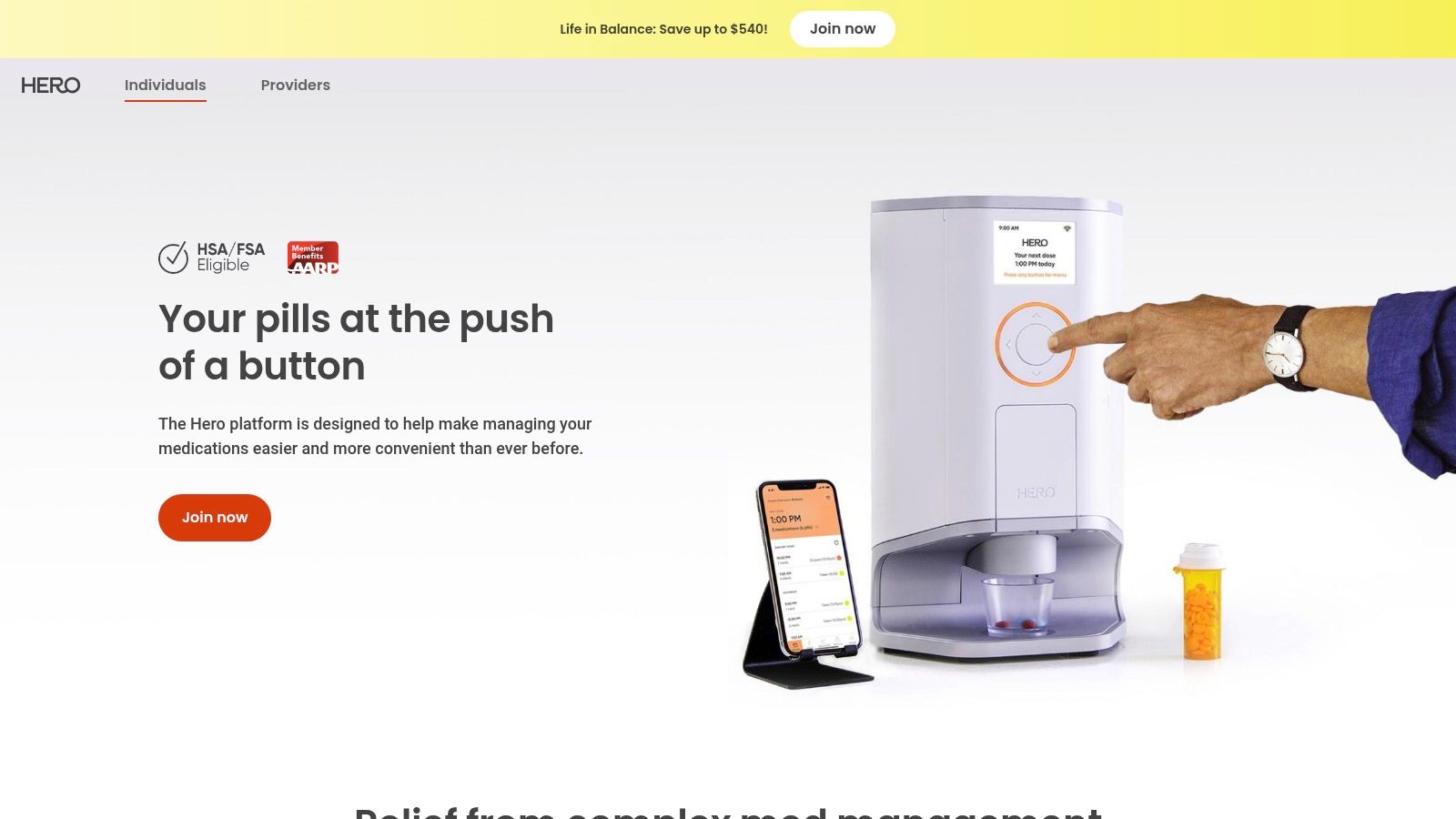
Automatic pill dispensers offer several key features that make them valuable aids for daily living. Many models, such as the one available from Hero Health (https://www.herohealth.com), can store up to a 28-day supply of medication, significantly reducing the need for frequent refills. The programmable nature of these devices allows for complex medication schedules to be easily managed, including multiple medications at different times of the day. The audio and visual alarms are customizable, ensuring they are noticeable but not disruptive. Critically, these dispensers often include a secure locking mechanism, preventing unauthorized access to the medications and mitigating the risk of accidental overdoses or tampering. A large LCD display clearly shows the time, date, and scheduled doses, further enhancing usability. Many models also include a battery backup feature, ensuring continued operation even during power outages.
While automatic pill dispensers provide numerous benefits, it’s important to consider the potential drawbacks. The cost, ranging from $100 to $300, can be a barrier for some individuals. While designed for ease of use, the initial programming can be challenging for users unfamiliar with technology. Family members or caregivers may need to assist with the initial setup and ongoing maintenance, which includes regular cleaning to ensure proper hygiene. It’s also important to note that these dispensers are primarily designed for oral medications in pill form; they are not suitable for liquid medications, injections, or other forms of medication delivery.
Compared to traditional pill organizers, which rely solely on the user’s memory and organization, automatic pill dispensers offer a significantly more advanced and reliable approach to medication management. Simple pill organizers can be easily misplaced, and they offer no reminders or safeguards against missed doses or accidental double-dosing. Automatic dispensers, on the other hand, provide a proactive, automated system that minimizes the risk of errors and provides peace of mind.
For families caring for elderly parents or loved ones with chronic illnesses, an automatic pill dispenser can be a game-changer. It reduces the burden on caregivers by automating a critical aspect of daily care. This allows caregivers to focus on other important aspects of caregiving, such as providing companionship, assisting with other activities of daily living, and ensuring overall well-being. For seniors living independently, these devices offer a crucial safety net, promoting independence and reducing the risk of medication-related complications.
Implementing an automatic pill dispenser requires careful planning and setup. Begin by creating a detailed list of all medications, including dosages and times. This information will be essential for programming the dispenser. Familiarize yourself with the device’s instructions and practice loading and programming the dispenser before putting it into regular use. Consider involving a family member or caregiver in the setup process, especially if the user is not comfortable with technology. Ensure the device is placed in a secure and accessible location. Finally, establish a routine for refilling and cleaning the dispenser to ensure its continued effectiveness. By carefully addressing these implementation steps, families and individuals can maximize the benefits of this important aid for daily living.
6. Voice-Activated Phone (GrandPad Tablet)
Maintaining connections with loved ones and accessing information easily becomes increasingly important as we age. For seniors and individuals with disabilities, navigating the complexities of modern technology can be a significant hurdle. The GrandPad tablet addresses this challenge by providing a simplified and secure digital experience designed specifically for these demographics, acting as a valuable aid for daily living. This specialized tablet streamlines communication, entertainment, and engagement, fostering independence and connection. Its user-friendly interface and robust features make it a valuable tool for improving the quality of life for seniors and those with disabilities. It deserves a place on this list due to its dedication to simplicity, accessibility, and dedicated support for its target users.
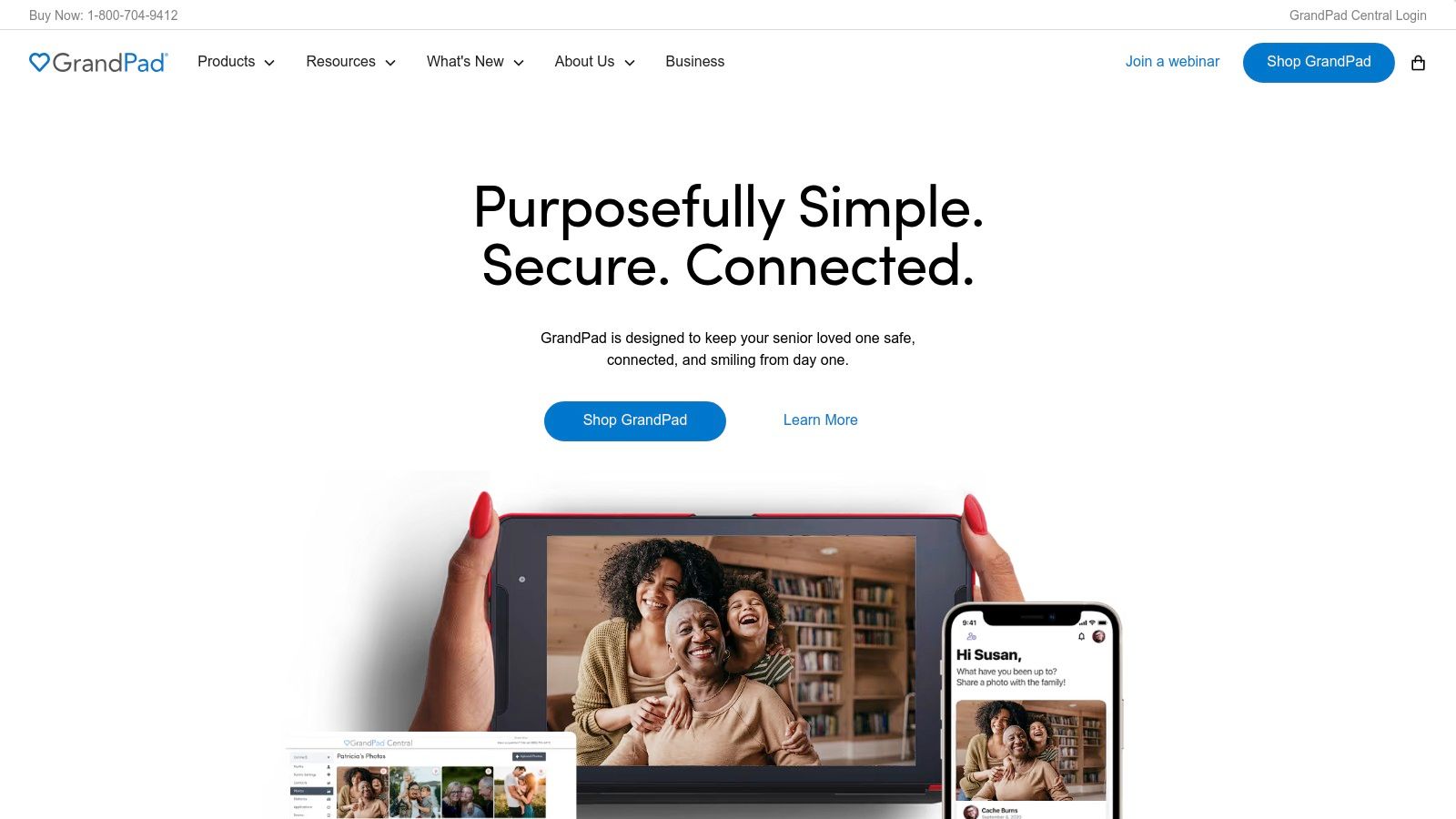
The GrandPad stands apart from conventional tablets with its pre-configured setup and focus on ease of use. Unlike standard tablets that often require intricate Wi-Fi configurations and app installations, the GrandPad arrives ready to use right out of the box. This plug-and-play functionality eliminates the technical barriers that can often frustrate seniors and individuals with cognitive impairments. This streamlined approach contributes significantly to making it a practical aid for daily living, enabling users to quickly access essential functions without the need for technical expertise.
A key feature of the GrandPad is its large, bright 8-inch touchscreen displaying clear, oversized icons. These icons represent core functionalities like video calling, messaging, photo viewing, and games, making navigation intuitive and effortless. For seniors with declining vision or dexterity issues, this simplified interface is crucial for independent usage. Voice-activated calling and messaging further enhance accessibility, allowing users to connect with family and friends without needing to type or navigate complex menus. This hands-free functionality is particularly helpful for those with arthritis or other conditions that limit hand movement.
For families, the GrandPad offers peace of mind and streamlined communication. The pre-configured family contact network allows approved family members to easily connect with the user. Furthermore, family members can remotely manage the device, adding new contacts, uploading photos, and ensuring the device remains updated. This remote management capability provides an additional layer of support, especially for seniors living independently. Regular automatic updates ensure the device is always running smoothly and securely, eliminating the need for the user to manage software updates themselves. This proactive approach simplifies maintenance and minimizes potential technical issues.
While the GrandPad offers significant advantages, it's crucial to consider its limitations. The monthly subscription fee of $79 can be a considerable expense compared to purchasing a standard tablet. Additionally, the GrandPad's locked-down system, while designed for simplicity and security, restricts users from downloading additional apps or customizing the device beyond the pre-configured options. This limited app selection contrasts sharply with the vast app ecosystem available on standard tablets, which might be a drawback for users seeking specific functionalities. Finally, the GrandPad's full functionality is contingent on the ongoing subscription. Without the subscription, many of the core features become inaccessible.
Compared to standard tablets, the GrandPad prioritizes ease of use, security, and dedicated support over expansive functionality and customization. This makes it a valuable aid for daily living for seniors and individuals with disabilities who might find standard tablets overwhelming. While other senior-friendly tablets exist, the GrandPad differentiates itself with its comprehensive support system, including device management and dedicated customer service.
Setting up the GrandPad is remarkably straightforward. It arrives pre-configured and with built-in 4G LTE connectivity, so no Wi-Fi setup is required. Simply turn on the device, and it's ready to use. Family members can then add contacts and personalize the device remotely through the online portal. The included professional customer support offers assistance for any technical issues or questions, ensuring users and their families always have access to help when needed.
The GrandPad is an investment in simplifying technology for seniors and individuals with disabilities, facilitating communication, and promoting independence. Its dedicated features and support make it a valuable aid for daily living, offering a tailored solution for those who might struggle with the complexity of standard tablets. While the cost and limited app selection should be considered, the GrandPad’s ease of use, security features, and dedicated support make it a worthwhile investment for many families. You can learn more and order a GrandPad from their website: https://www.grandpad.net
7. Shower Chair with Back Support
A shower chair with back support is a crucial aid for daily living, designed to enhance bathroom safety and independence for individuals facing mobility challenges, balance issues, or fatigue. This medical-grade chair provides secure seating during bathing, reducing the risk of falls and making the showering experience more comfortable and manageable. Its features, including adjustable height, non-slip feet, and drainage holes, are thoughtfully designed to address the specific needs of users requiring assistance in the bathroom. This simple yet effective tool can significantly improve the quality of life for seniors and individuals with disabilities, enabling them to maintain personal hygiene and dignity. A shower chair with back support rightfully earns its place on this list due to its ability to transform a potentially hazardous activity into a safe and relaxing experience, promoting both physical and emotional well-being.
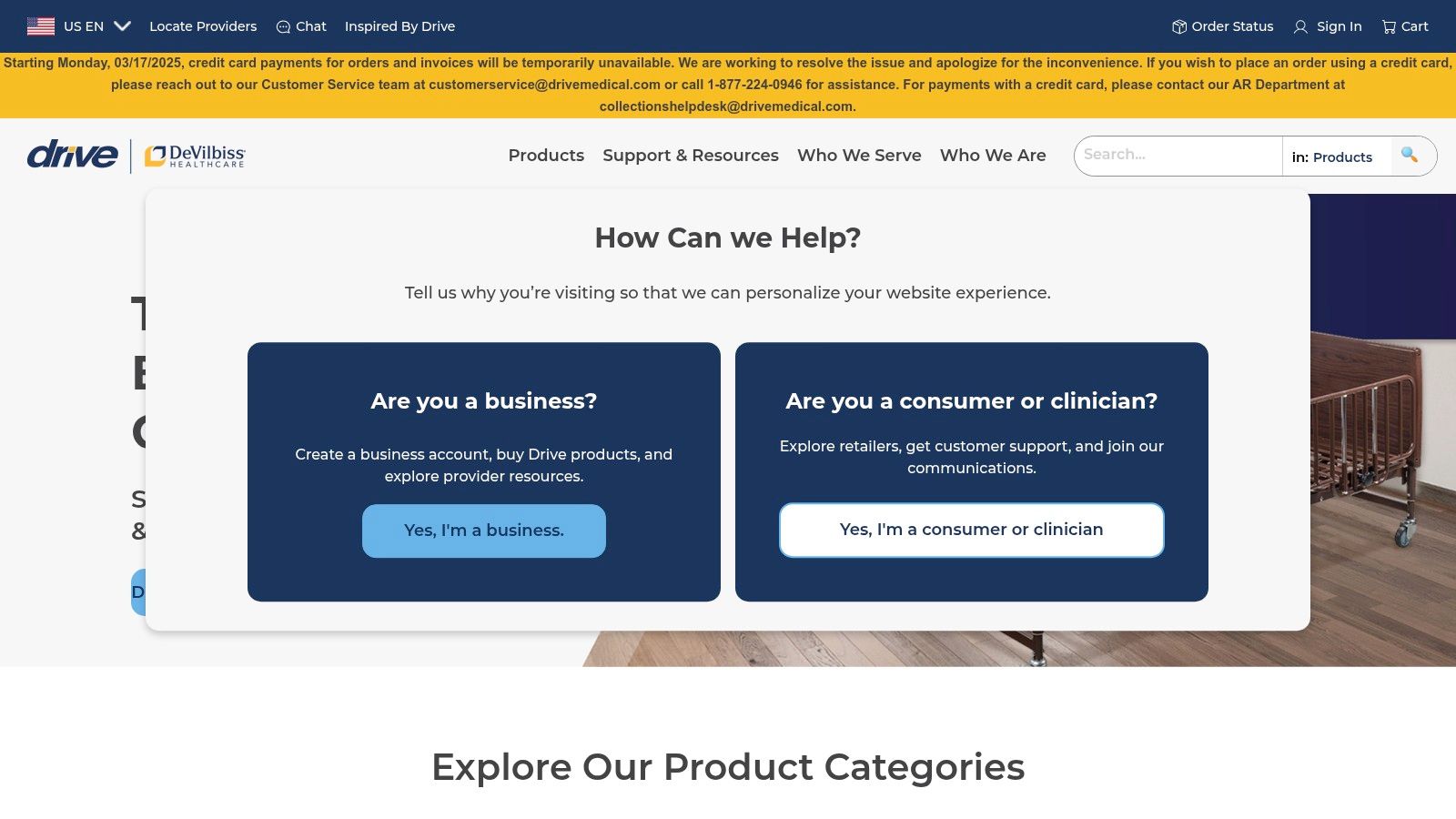
For seniors aging in place, a shower chair with back support is often an essential aid for daily living. It allows them to maintain independence in their own homes by mitigating the risks associated with showering. Family caregivers benefit as well, as the chair reduces their physical strain and provides peace of mind knowing their loved one is safe during bathing. Individuals recovering from surgery or illness can also utilize a shower chair during their rehabilitation process. The adjustable height feature (typically ranging from 16-20 inches in this model) allows customization for individual needs and varying shower stall dimensions. The tool-free assembly and height adjustment make it easy to set up and modify without needing any specialized tools. The non-slip rubber feet provide stability on wet surfaces, preventing accidental slips, while drainage holes prevent water from pooling on the seat, enhancing comfort and hygiene. The robust construction supports a weight capacity of up to 300 pounds, catering to a wide range of users. The affordability of these chairs, generally priced between $40 and $80, makes them an accessible solution for many.
While shower chairs with back support offer numerous benefits, considering potential limitations is important. They may not fit all shower configurations, particularly in very small or unusually shaped stalls. Adequate shower space is required to maneuver the chair safely. The seat material, while durable and easy to clean, can sometimes feel cold to the skin initially. However, this can often be mitigated by briefly running warm water over the seat before use. The non-slip rubber feet, while designed for longevity, may require replacement over time due to wear and tear.
Compared to other bathing aids, such as grab bars or bath benches, shower chairs offer more comprehensive support, particularly for individuals with significant balance issues or limited mobility. Grab bars, while useful for stability, don't provide a seated resting option. Bath benches, although offering a seating solution, often lack back support, which can be crucial for individuals with weakened core muscles or back pain.
Implementation is straightforward. After ensuring the chair fits comfortably within the shower stall, adjust the height to a suitable level for the user. Confirm the non-slip feet are securely in place. Before each use, check the stability of the chair and ensure the drainage holes are clear. Regular cleaning with mild soap and water will maintain hygiene and prolong the chair's lifespan. Learn more about Shower Chair with Back Support for advice on adapting home environments for seniors and those with mobility limitations.
This shower chair with back support, available at Drive Medical, is an invaluable aid for daily living, offering a safe, comfortable, and affordable way to enhance bathroom independence. It represents a vital tool for seniors, individuals with disabilities, and their caregivers, improving safety, comfort, and overall well-being during bathing. For Medicaid beneficiaries and their families, this affordable aid can significantly improve the quality of life at home. Hospital discharge planners and healthcare professionals can recommend this aid to patients transitioning back home, aiding in their recovery and promoting independent living.
8. Smart Thermostat (Nest Learning Thermostat)
Maintaining a comfortable home temperature is a crucial aspect of daily living, especially for seniors and individuals with mobility limitations. A smart thermostat, like the Nest Learning Thermostat, can significantly improve quality of life by automating and simplifying climate control, making it a valuable aid for daily living. For seniors aging in place, the ability to easily adjust the temperature without having to physically reach a thermostat can be a game-changer. This is especially true for those with conditions like arthritis or limited mobility. This device seamlessly integrates into a broader strategy for independent living and fits perfectly within the services and goals outlined by organizations like Caring Hands Senior Services.
The Nest Learning Thermostat distinguishes itself through its learning capabilities. Over time, it observes your temperature adjustments and builds a personalized schedule, automatically adjusting the temperature throughout the day to match your preferences. Imagine waking up to a comfortably warm house in the winter without having to manually adjust the thermostat. This "set it and forget it" approach is a significant benefit for those who may find frequent adjustments challenging.
Beyond automated scheduling, the Nest Learning Thermostat offers a suite of features designed for convenience and accessibility. Control your home's temperature from anywhere using the user-friendly smartphone app. This is invaluable for family caregivers who can remotely monitor and adjust the temperature for their loved ones, ensuring their comfort even when they are not physically present. Furthermore, voice control compatibility with popular platforms like Alexa and Google Assistant allows for hands-free operation. Simply say "Hey Google, set the temperature to 72 degrees," and the Nest Learning Thermostat will comply. This feature is especially helpful for individuals with limited dexterity or those who use wheelchairs.
Learn more about Smart Thermostat (Nest Learning Thermostat) to explore how it aligns with senior health and wellness goals. Caring Hands Senior Services recognizes the importance of aids for daily living like the Nest thermostat in enabling seniors to age gracefully and maintain their independence.
The energy-saving features of the Nest Learning Thermostat are another significant advantage. By optimizing heating and cooling schedules and providing usage reports, it can help reduce energy consumption by an estimated 10-15%, leading to lower utility bills. This is a welcome benefit for seniors living on fixed incomes. The easy-to-read display is also a plus, allowing users to see the current temperature and settings from across the room. Moreover, the Nest Learning Thermostat can integrate with other smart home devices, further enhancing convenience and control.
While the Nest Learning Thermostat offers numerous advantages, it’s essential to consider the potential drawbacks. The upfront cost, ranging from $200-$250, is higher than traditional thermostats. Professional installation, often recommended for optimal performance, adds another $150+ to the initial investment. A reliable Wi-Fi connection is also essential for the thermostat to function correctly. Finally, during the initial learning period, the thermostat might make some temperature adjustments that don't perfectly align with your preferences, leading to temporary discomfort. However, this is usually resolved as the system learns your habits.
In comparison to other smart thermostats on the market, the Nest Learning Thermostat stands out with its intuitive learning algorithm and sleek design. While some competitors offer similar features, the Nest’s user-friendly interface and seamless integration with other Google products make it a popular choice.
For those considering purchasing a Nest Learning Thermostat, here are some implementation tips:
- Professional Installation: While DIY installation is possible, professional installation is recommended, especially for those unfamiliar with wiring. This ensures proper setup and minimizes potential issues.
- Wi-Fi Connectivity: Ensure a strong and stable Wi-Fi signal reaches the thermostat's location.
- Patience During Learning Period: Allow the thermostat a few weeks to learn your preferences. Resist constantly overriding the automatic adjustments, as this can hinder the learning process.
- Explore the App: Familiarize yourself with the smartphone app and its features to maximize the thermostat's potential.
The Nest Learning Thermostat, as an aid for daily living, offers significant benefits for seniors, individuals with mobility limitations, and their caregivers. By automating temperature control, providing remote access, and offering energy-saving features, it contributes to a more comfortable, convenient, and independent lifestyle. While the initial cost might be higher than traditional thermostats, the long-term benefits in terms of comfort, convenience, and potential energy savings make it a worthwhile investment. You can find more information and purchase the Nest Learning Thermostat at https://store.google.com/nest-learning-thermostat.
Assistive Devices Comparison Matrix
| Product | Core Features & Unique Points ✨ | User Experience & Quality ★★★★☆ | Value & Pricing 💰 | Target Audience 👥 | Highlight 🏆 |
|---|---|---|---|---|---|
| Amazon Echo Show 8 (3rd Gen) | 8" HD touchscreen, Alexa, smart home hub, reminders | Hands-free, clear display, regular updates | Moderate; some features need subscription | Seniors needing digital assistance | Smart home integration & video calls |
| Philips Lifeline Medical Alert | 24/7 monitoring, waterproof help button, GPS option | Quick emergency response, waterproof design | High monthly fee ($50-70) | Seniors needing emergency support | Trusted 45+ years monitoring |
| GripWare Non-Slip Tableware Set | Non-slip base, built-up handles, high-contrast colors | Durable, easy to clean, improves dining safety | Affordable | Seniors with hand strength issues | Adaptive dining aid affordability |
| Reacher Grabber Tool (32-inch) | 32" reach, ergonomic grip, magnetic tip | Lightweight, reduces strain, easy to store | Very affordable ($15-25) | Mobility-limited individuals | Prevents falls, lightweight design |
| Automatic Pill Dispenser w/ Alarms | 28-day programmable, alarms, secure locking | Reduces medication errors, easy to program | Mid to high cost ($100-300) | Seniors managing multiple meds | Medication adherence aide |
| Voice-Activated Phone (GrandPad) | 8" touchscreen, voice activation, 4G included | Simple use, family remote access | High monthly subscription ($79) | Seniors needing easy communication | Senior-friendly, no setup needed |
| Shower Chair with Back Support | Adjustable height, non-slip feet, drainage holes | Sturdy, safe, easy maintenance | Affordable ($40-80) | Mobility-challenged seniors | Bathroom safety enhancement |
| Smart Thermostat (Nest) | Learning thermostat, remote & voice control | Energy-saving, easy to read | High upfront & install cost ($200-400) | Seniors with mobility issues | Energy savings & smart control |
Choosing the Right Aids for Daily Living
Selecting the appropriate aids for daily living is crucial for maximizing independence and enhancing quality of life. Throughout this article, we've explored a range of tools, from smart home devices like the Amazon Echo Show and Nest Learning Thermostat to essential assistive aids such as grabber reachers, non-slip tableware, and shower chairs. Remember, the most effective aids for daily living are those tailored to individual needs and preferences. Factors such as physical limitations, cognitive abilities, and the home environment play a significant role in determining the right tools. For example, while a voice-activated phone like the GrandPad can be invaluable for seniors with dexterity challenges, a medical alert system like Philips Lifeline provides critical peace of mind for those at risk of falls. Similarly, automated pill dispensers promote medication adherence, while smart thermostats can simplify environmental control.
Implementing these tools effectively also requires careful consideration. Start by introducing aids gradually and providing ample instruction and support to ensure comfortable adoption. Regularly assess the effectiveness of the aids and make adjustments as needed. Consulting with healthcare professionals or occupational therapists can offer valuable insights into selecting and utilizing aids for daily living that best address specific challenges.
Ultimately, choosing the right aids for daily living empowers individuals to maintain greater control over their daily routines and enjoy a richer, more fulfilling life. For personalized guidance and support in navigating the world of aids for daily living in the Mercer County area, including Hamilton and Princeton, connect with Caring Hands Senior Services. We offer expert assistance in selecting and implementing the right tools and provide comprehensive in-home care services to further enhance comfort and well-being. Caring Hands Senior Services

